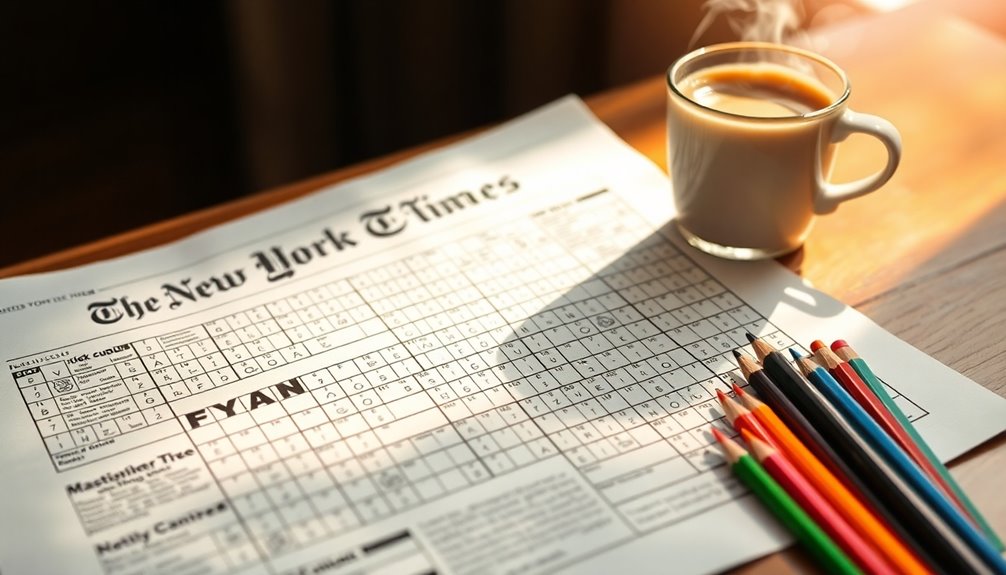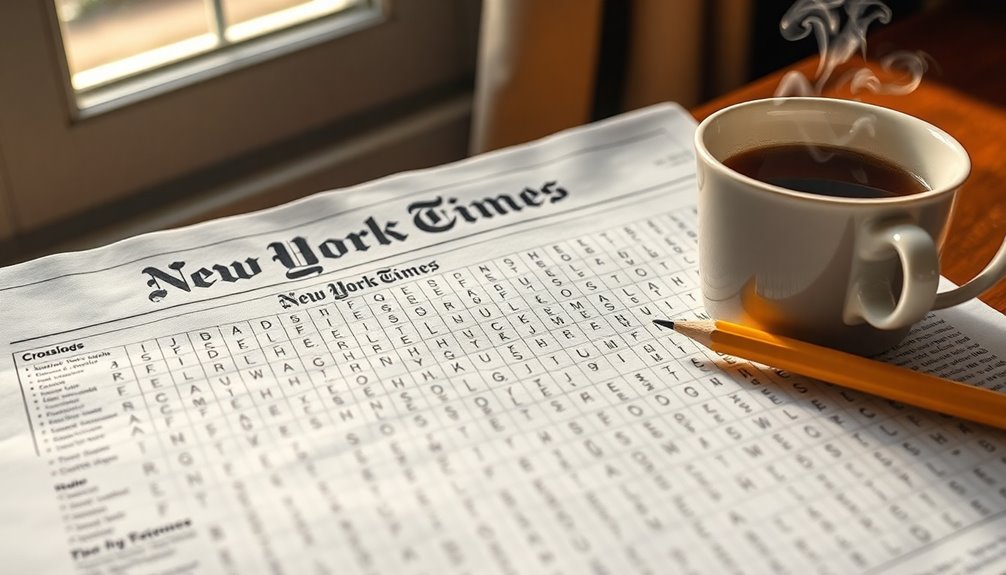The easiest day for the New York Times Crossword is Monday. These puzzles are designed for beginners, featuring straightforward clues and less complex themes. Starting with Monday helps you build a solid foundation and boosts your confidence. As you get comfortable, you can shift to Tuesday, which offers a slight increase in difficulty. Familiarizing yourself with common crosswordese and employing tips like taking breaks can enhance your solving experience. Engaging with the crossword community can also offer valuable insights. Stick around, and you'll find even more strategies to improve your skills and enjoy the puzzles fully.
Key Takeaways
- Monday is the easiest day for the New York Times Crossword, designed specifically for beginners to build their skills and confidence.
- Tuesday puzzles offer a slight increase in difficulty, maintaining a manageable and enjoyable experience for new solvers.
- Starting with easier puzzles helps familiarize solvers with common crossword structures and clue interpretations, making future puzzles less daunting.
- Engaging with themed puzzles enhances enjoyment, as themes can simplify clues and create a cohesive narrative throughout the crossword.
- Regular practice on easier puzzles leads to improved solving skills, enabling solvers to tackle more challenging puzzles over time.
Overview of Crossword Difficulty

When you plunge into the New York Times Crossword, you'll quickly notice that the difficulty varies throughout the week.
Monday puzzles stand out as the easiest, specifically designed for beginners with straightforward clues. You'll find that these puzzles help you build confidence as you start your crossword journey.
As you progress to Tuesday, the difficulty only slightly increases, keeping the experience enjoyable.
The challenge ramps up considerably by Saturday, where you'll face intricate wordplay and tricky clues that demand advanced solving skills.
Sundays feature a larger grid but are generally not the hardest, thanks to their theme-based clues.
This structure makes it clear that starting with Mondays is a smart choice for those new to crosswords.
Benefits of Starting With Mondays

Starting your crossword journey with Monday puzzles offers a solid foundation for developing your skills and confidence. These puzzles are designed to be the easiest of the week, so you'll find straightforward clues that won't overwhelm you. Completing multiple Monday puzzles helps you build familiarity with crossword structures and clue interpretations.
| Benefits | Details |
|---|---|
| Easy Clues | Straightforward and less complex |
| Builds Confidence | Regular practice boosts your self-assurance |
| Improves Solving Skills | Enhances your ability to tackle tougher puzzles |
| Suitable Progression | Shifting to Tuesday puzzles remains manageable |
Understanding Puzzle Themes

As you progress from Monday puzzles to more challenging ones, you'll encounter various themes that add depth to your solving experience. Recognizing these themes can simplify your journey, as they often provide context for clues and longer answers.
Here are four reasons why themes matter:
- They can clarify tricky clues, leading you to the right answers.
- Clever wordplay enhances the challenge and fun of solving.
- Themes create a sense of satisfaction when you connect the dots.
- Understanding the theme transforms a puzzle into a cohesive story.
While you can solve puzzles without them, embracing themes makes your experience richer and more enjoyable.
Tips for Effective Solving

To tackle the New York Times Crossword effectively, it's essential to approach each puzzle with the right mindset and strategies.
Start with the Monday puzzle, as it's designed to be the easiest of the week, featuring straightforward crossword clues that build your confidence. Familiarize yourself with common crosswordese; knowing these frequently used words can greatly boost your solving efficiency.
Utilize the autocheck feature on digital platforms to verify answers, reinforcing your learning. If you hit a wall, take a break—returning with fresh eyes often reveals overlooked answers.
Finally, engage with resources like the Wordplay column or community forums for insights and additional tips for effective solving. These strategies will enhance your overall experience and skill level.
Common Crossword Gimmicks

Having a grasp of effective solving strategies can really help when you encounter common crossword gimmicks. These clever devices often enhance your solving experience by incorporating a theme or playful interpretations.
Here are some common gimmicks to watch for:
- Themed Answers: Look for patterns that connect the clues and answers.
- Tricky Structures: Some puzzles require you to form shapes, like the "Downright Tricky!" with six Ls.
- Punny Clues: A question mark often signals a playful twist on common phrases.
- Long Answers: Recognizing the theme can help you predict these answers.
Understanding these common gimmicks can boost your confidence and aid in filling those tricky remaining clues.
Happy solving!
Consistency in Tenses

When you tackle a crossword, paying attention to tense consistency is key.
If a clue's in the present tense, you'll want to make sure your answer matches that tense. This alignment not only helps you connect clues to answers accurately but also makes the whole solving process smoother.
Present Tense Clues
Understanding the relationship between clue and answer tenses is key for solving crossword puzzles efficiently. When you encounter present tense clues, remember that your answers must also reflect that tense. This consistency helps in achieving clarity and boosts your solving speed.
Here are some reasons to embrace present tense clues:
- They simplify the solving process.
- They reduce confusion, allowing for quicker identification of answers.
- They align with common clue types used in puzzles.
- They enhance your overall crossword experience.
Answer Tense Alignment
Consistency in tenses is essential for mastering crossword puzzles and can greatly streamline your solving process. When you encounter a clue, the tense used indicates what form the answer should take. For instance, if a clue is in the past tense, you should respond with a past tense answer for proper answer tense alignment.
This tense consistency not only clarifies expectations but also narrows down your possible answers. By recognizing the relationship between clue tense and answer form, you enhance your accuracy and efficiency in solving. Keeping this alignment in mind allows you to tackle puzzles more effectively and enjoyably, making the overall experience smoother and more rewarding.
Consistency Aids Solving
While solving crossword puzzles, paying attention to tense consistency can greatly enhance your experience. When clues are asking for a specific tense, aligning your answers accordingly reduces confusion and improves clarity.
Here are some key points to remember:
- Present tense clues require present tense answers.
- Singular clues lead to singular answers; plurals do the same.
- Awareness of tense helps you navigate tricky clues.
- Mismatched tenses can lead to incorrect answers and frustration.
Strategies for Overcoming Challenges

To tackle the challenges of the New York Times Crossword, you should practice regularly to build your skills and confidence.
Embracing mistakes as part of the learning process will help you improve and stay engaged.
Practice Regularly
Practicing regularly can make a significant difference in your crossword-solving skills. By focusing on easier puzzles like Monday's, you'll build a solid foundation and boost your confidence.
Here are some strategies to enhance your practice:
- Solve mini puzzles to improve speed and familiarity.
- Learn common crossword words, or "crosswordese," to enhance efficiency.
- Take breaks when you're stuck; fresh perspectives often reveal solutions.
- Use external resources, such as crossword blogs, for hints and strategies.
Additionally, consider joining writing groups for support and motivation, as they can provide valuable insights and encouragement that may translate into improved puzzle-solving skills.
Embrace Mistakes
Mistakes are inevitable in crossword solving, but instead of viewing them as setbacks, consider them valuable learning opportunities. Embracing mistakes can actually enhance your problem-solving skills, as it's common to face initial difficulties.
When you hit a wall, take a break; a fresh perspective often leads to unexpected breakthroughs. Developing strategies, like identifying patterns or familiar words, helps reduce frustration and builds confidence.
Remember to celebrate small victories, whether it's completing a single answer or finishing an entire puzzle. Acknowledging that mistakes are a natural part of your crossword journey encourages a more relaxed approach, making the process enjoyable.
Embrace the learning curve, and you'll find yourself improving with each puzzle you tackle.
Using Easy Mode for Help

If you're feeling overwhelmed by the challenge of the New York Times Friday crossword, Easy Mode can be your perfect solution. This feature simplifies clues, making it easier for novice solvers to build confidence.
Here are some reasons to give Easy Mode a try:
- Simplified Clues: Easier hints help you grasp concepts without frustration.
- Gradual Skill Building: You can improve your skills step-by-step, preparing for tougher puzzles.
- Accessible Experience: It creates a less intimidating environment for beginners.
- Crossword Tips Included: You'll receive helpful advice with your subscription, enhancing your solving journey.
Engaging With the Crossword Community

Engaging with the crossword community can transform your solving experience into a more enjoyable and enriching journey. By connecting with others, you'll enhance your problem-solving skills through shared insights and strategies. The comments section on puzzle platforms is a great space to discuss thoughts and gather encouragement from fellow enthusiasts.
| Benefits of Community | How to Engage |
|---|---|
| Enhanced problem-solving | Join online forums |
| Diverse perspectives | Participate in discussions |
| Access to resources | Follow social media groups |
Participating in these spaces connects you with seasoned solvers who offer valuable advice and support. Plus, resources like Deb Amlen's guide help you grasp crossword lingo, improving your overall puzzle-solving abilities.
Frequently Asked Questions
What Is the Easiest Day to Crossword in NY Times?
If you're looking for the easiest day to tackle a New York Times crossword, you'll find that Monday is your best bet. The clues are straightforward, making it perfect for beginners like you.
As you complete more Monday puzzles, you'll boost your confidence and get a feel for crossword structure. Once you've mastered these, try Tuesday puzzles for a slightly greater challenge.
Regular practice will sharpen your skills for tougher puzzles later in the week.
What Is the Easiest New Yorker Crossword Day?
Imagine you're a gardener, nurturing new plants. Just like the simplest seeds sprout first, the easiest New Yorker crossword day is often the Monday puzzle.
These puzzles offer a gentle introduction, with straightforward clues that allow you to cultivate your skills. As you progress, you'll find Tuesday and beyond more challenging, like tending to more complex flowers.
What Is the Average Time to Finish the Nyt Crossword?
The average time to finish a New York Times Crossword varies based on the day.
If you're tackling a Monday puzzle, you can expect to spend about 10 to 15 minutes. For Tuesday, it might take you 15 to 20 minutes, and Wednesdays could stretch to 20 to 30 minutes.
As the week progresses, the puzzles get tougher, and you could find yourself spending 30 minutes or more on Thursday and Friday.
How to Get Better at New York Times Crossword Puzzle Clue?
Ever felt like a detective piecing together clues? To get better at the New York Times crossword, start with Monday puzzles—they're the easiest.
Familiarize yourself with common crosswordese and seek out patterns in clues. Don't shy away from using the autocheck feature to learn from your errors.
Practice consistently, even with mini puzzles, to sharpen your skills and boost your confidence. Before you know it, those tricky clues won't stand a chance!
Conclusion
In summary, whether you're a seasoned solver or just starting out, tackling the New York Times crossword can be a rewarding challenge. Embrace the ease of Mondays, explore the themes, and engage with the community. Remember, practice makes progress, patience leads to clarity, and persistence fosters skill. By honing your strategies and utilizing available resources, you'll transform frustrations into triumphs. So grab a pencil, immerse yourself, and enjoy the journey of solving!









